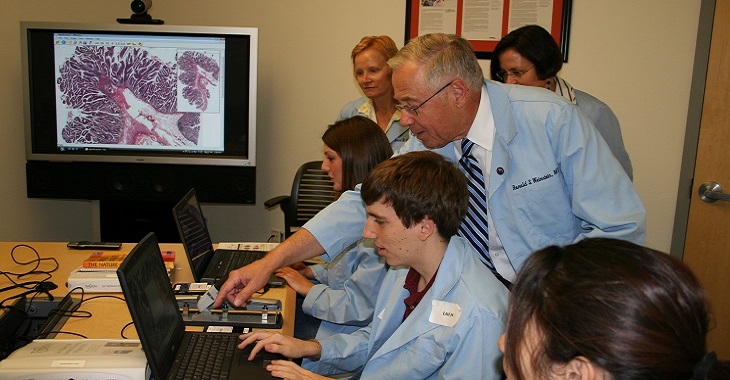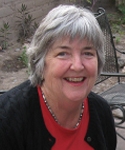A medical breakthrough in 1986 has changed the practice of medicine around the world: the invention of telepathology, the diagnosis of surgical pathology slides at a distance.
Invented, patented and commercialized by Ronald S. Weinstein, MD, University of Arizona professor of pathology and founding director of the Arizona Telemedicine Program, telepathology was demonstrated in 1986. A 66-year-old breast cancer patient in El Paso, Texas, had her breast biopsy diagnosis verified by a surgical pathologist in Washington, D.C., via satellite communications and tele-robotic light microscopy.
At the time, the public demonstration of the new technology was attended by the assistant surgeon generals of the U.S. Army and U.S. Air Force and leaders of Washington, D.C.-area medical schools. The story was picked up by television stations and printed in dozens of newspapers, including the Wall Street Journal and the Washington Post.
Dr. Weinstein’s research team, then at Rush Presbyterian Hospital in Chicago (now known as Rush University Medical Center), published the first telepathology papers in the scientific literature and added the term “telepathology” to the English language. Dr. Weinstein frequently is referred to as the “Father of Telepathology.”
The technique is used in 32 countries, and thousands of patients around the world have benefited from often-immediate access to pathology subspecialists via telepathology, as compared to time-consuming physical shipment of pathology specimens. This in turn increases diagnostic accuracy and reduces the patient’s anxiety that comes from waiting weeks for laboratory reports in some countries.
Subspecialty pathologists are rare in many countries. In the field of diagnostic pathology, there are more than 20 subspecialties, including neuropathology, dermatopathology, renal pathology, hematopathology and medical microbiology. Pathology subspecialists provide the highest levels of diagnostic accuracy in medicine, render diagnoses on the most complex cases, and are experts in advanced molecular testing of tissue specimens.
Recently, an international survey of clinical trials of telepathology showed “greater efficiencies in terms of time for diagnoses” and was published by three past presidents of the American Telemedicine Association (ATA) and leaders in academic telemedicine: Dr. Weinstein; Rashid L. Bashshur, PhD, of the University of Michigan (lead author and the top scholar in the telemedicine field); and Elizabeth A. Krupinski, PhD, of Emory University, UA professor emerita and co-director of the Southwest Telehealth Resource Center. The article marked the 30th anniversary of Dr. Weinstein’s invention. (The 25th anniversary had been commemorated in 2011 at an international meeting on telepathology in Venice, Italy, at which Dr. Weinstein gave the keynote address.)
The report, available free without a subscription until March 7 on the Telemedicine & e-Health website at https://dx.doi.org/10.1089/tmj.2016.0278, summarizes the results of 77 feasibility studies conducted in 27 countries and two multi-national groups between 2005 and 2016. They include one 12-year study of more than 11,000 patients in the U.S. Department of Veterans Affairs, using telepathology equipment designed by Dr. Weinstein.
Studies in China showed that “telepathology can improve cancer care in a large developing country,” Dr. Weinstein said. “China lags far behind the United States in its creation of its subspecialty pathology workforce. This could become a barrier to the Chinese implementations of precision medicine down the road.”
Dr. Weinstein has traveled widely in China and has been a frequent speaker at China’s national academic pathology meetings. As a past president of the United States and Canadian Academy of Pathology, he helped organize the first international pathology meeting in China in 1989 and was the meeting’s first keynote speaker. That marked the beginning of Chinese efforts to expand subspecialty pathology services using telepathology throughout the country, with Dr. Weinstein serving as outside expert.
The first international demonstration of telepathology, between China and the United States, was organized in October 1993 by Dr. Weinstein, then head of pathology at the UA. Patients in China were linked to telepathologists at the University of Arizona in Tucson. Achyut Bhattacharyya, the current head of pathology, rendered the first diagnosis on a middle-aged Chinese man with stomach cancer. This historic demonstration was widely televised in China.
Roche, now the parent company of Ventana Medical Systems, Inc., provided the telepathology equipment; today major companies with telepathology products include Ventana Medical Systems, Olympus Corporation and Philips Healthcare. “There are large telepathology networks in China today, following our lead,” said Dr. Weinstein. “One Chinese program alone, reviewed in our survey, had rendered 16,247 telepathology diagnoses by 2014.”
Forty percent of the world’s pathologists practice in the United States, where they serve just 4 percent of the world’s population.
“There are huge disparities in access to pathologists around the world,” Dr. Weinstein said. “Many countries are unable to qualify patients for certain modern therapies. According to the World Health Organization, cancer cases will increase nearly 70 percent in the next 20 years, with 1.4 million of them being misdiagnosed. Telepathology can be the solution, by leveraging the expertise of subspecialty pathologists everywhere.”

